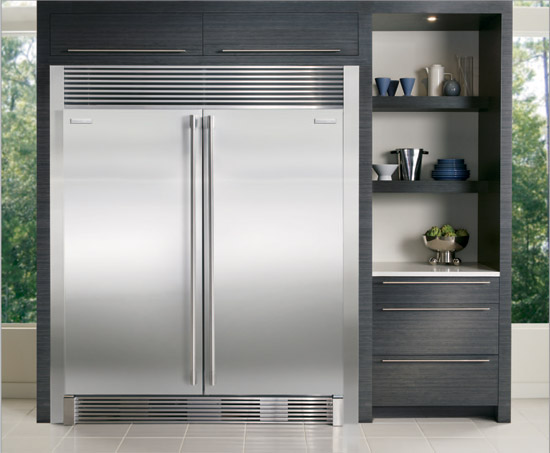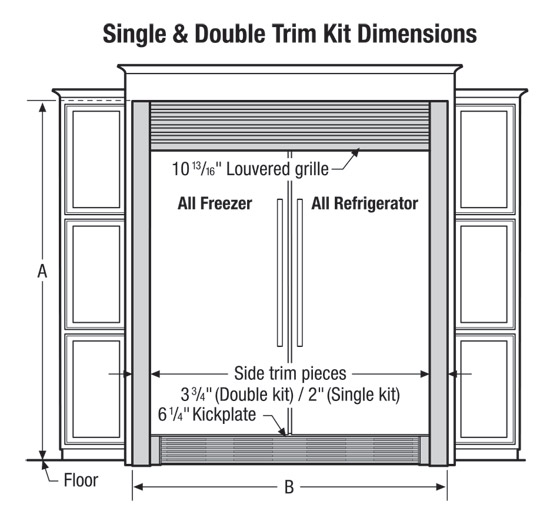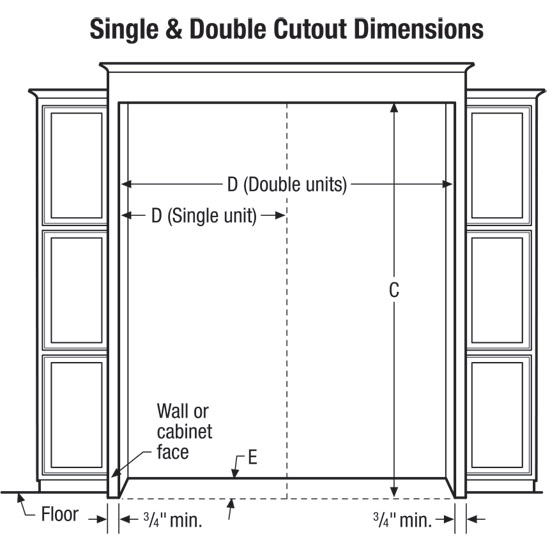Using Built-in Appliances to Enhance Design
Refrigeration Appliances
The most common refrigeration appliance is a combination refrigerator/freezer with choices on door configurations, size, and overall capacity. When designing so this appliance achieves a built-in look, there are several standard dimensions to consider regardless of the manufacturer or brand name on the appliance. The standard width of most full-size refrigerator/freezers is a nominal 36 inches with a standard height of approximately 69 inches.
The variable which will directly affect cubic footage capacity is the depth of the appliance. The standard depth is roughly 28-½ inches (not counting the depth of the doors) which means it is deeper than a conventional 24-inch-deep kitchen cabinet or a standard 25-inch-deep countertop. Hence, for a built-in look that is closer to being flush with kitchen cabinetry, a counter-depth refrigerator/freezer is available which is approximately 23-½ inches deep. In this case, cabinetry can be framed around the appliance which will protrude less into the workspace.
The cabinet-depth appliances will logically provide less cubic footage (on the order of 20 to 25 cubic feet) than standard-depth units (25 to 32 cubic feet) but variations in models and manufacturing approaches will impact this. Hence it is best to compare carefully to be sure that the designed opening for the refrigerator/freezer will meet the capacity requirements of the occupant/user.
 |
Separate full refrigerator and full freezer appliances can be built in to provide the clean appearance of one combined appliance. Photo courtesy of Electrolux |
To complete the built-in look, adding a manufacturer-supplied trim kit around the sides and top of the unit will eliminate any gaps and give the unit a completely finished look. Note that air must circulate around the unit to allow the heat transfer to occur out of the appliance so it can perform as intended. Depending on the make and model, a louver may be required above the appliance for air flow in addition to whatever air flow is built in to the bottom kick plate area. Check the specifications, clearances, cut out sizes, and air flow requirements published by the manufacturer to determine what is needed in a given design situation.
If a refrigerator/freezer appliance does not appear to meet the food storage needs of a user, then there are two fundamental options. Either increase the size to a larger unit or add supplemental refrigeration appliances. Generally, it is usually less costly and more energy efficient to run one larger refrigerator rather than two smaller ones. However, for design situations that call for a variety of notably different refrigeration needs including different temperature settings for significant quantities, then multiple units may be a logical choice.
Larger refrigeration appliances fall into two basic categories. First, a 6-inch-wider built-in refrigerator/freezer unit is commonly manufactured in a 42-inch nominal width. Typically, both the volume in the freezer and the refrigerator portions are increased, but direct comparisons between models is recommended to discern actual differences. Second, it is quite possible to select individual appliances that are all refrigerators or all freezers but each with the appearance of a standard refrigerator. These appliances are commonly narrower at a nominal 32 inches wide and a cubic volume less than 20 cubic feet, each. That is smaller than the total volume of the appliances described above, but when two units are used, it provides larger dedicated capacities for both refrigerator and freezer space. The two units can be separated in the kitchen based on workflow and convenience or they can be located next to each other to appear as one larger 64-inch-wide appliance.
 |
 |
|
Images courtesy of Electrolux |
The choice to use multiple sizes and types of refrigeration appliances often comes down to specific needs. General-use refrigerators are typically kept between 35 to 38 degrees Fahrenheit for best food storage and efficiency of operation. This is colder than would be needed or recommended for wine storage for example which is typically in the 50 to 60 degree range.
If wine cooling is needed, then it may be more energy efficient and practical to use a separate appliance such as an under-counter wine cooler which can be set to the best temperature for this purpose. This leaves room in the main refrigerator for other uses or may allow for a smaller size to become practical. Similarly separate, smaller, under-counter ice makers may also be logical in situations where they are needed only occasionally and can be turned off in between uses. For other remote locations such as a wet bar or serving area, a smaller built-in refrigerator drawer may be all that is needed rather than a second full-size unit.









